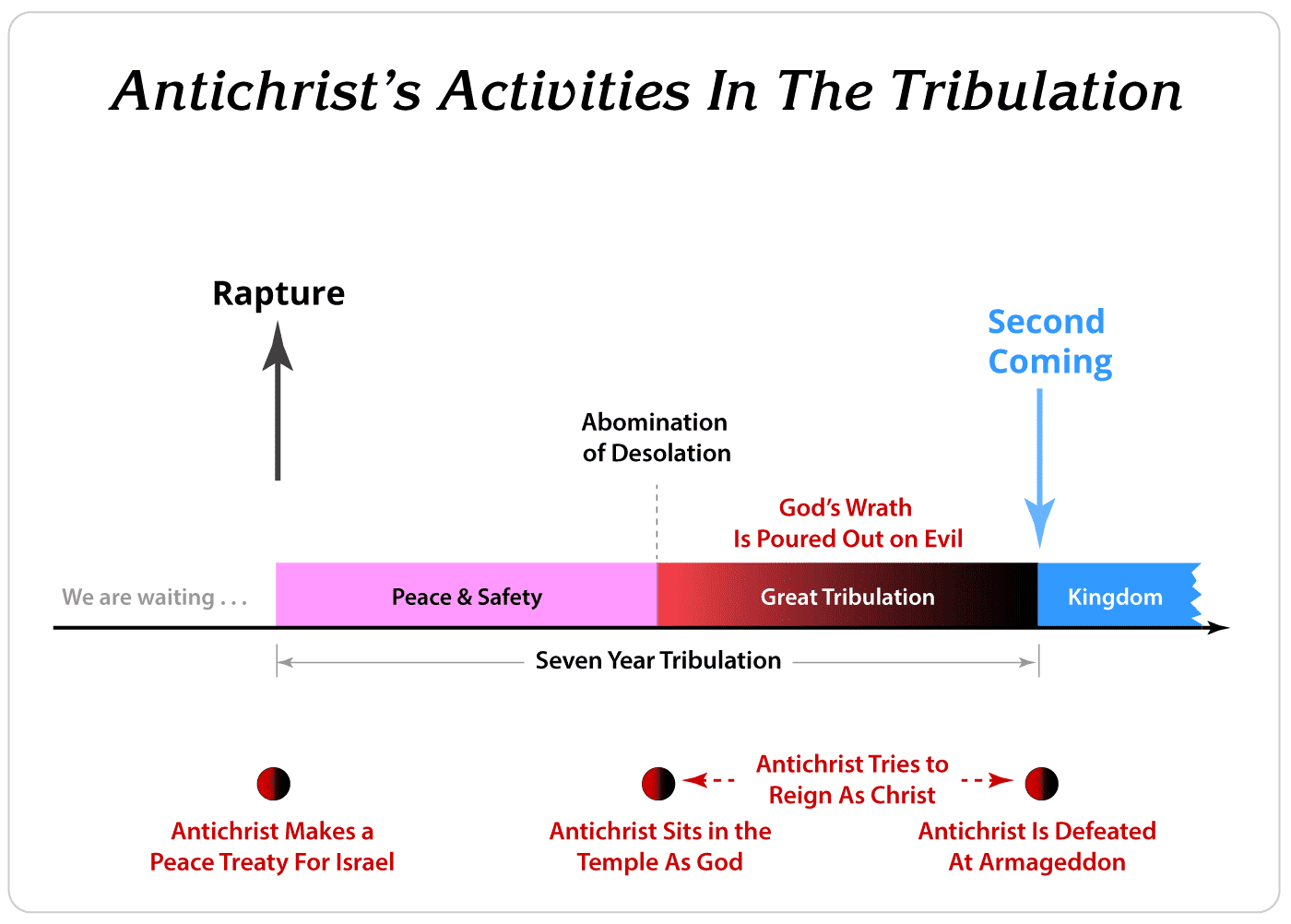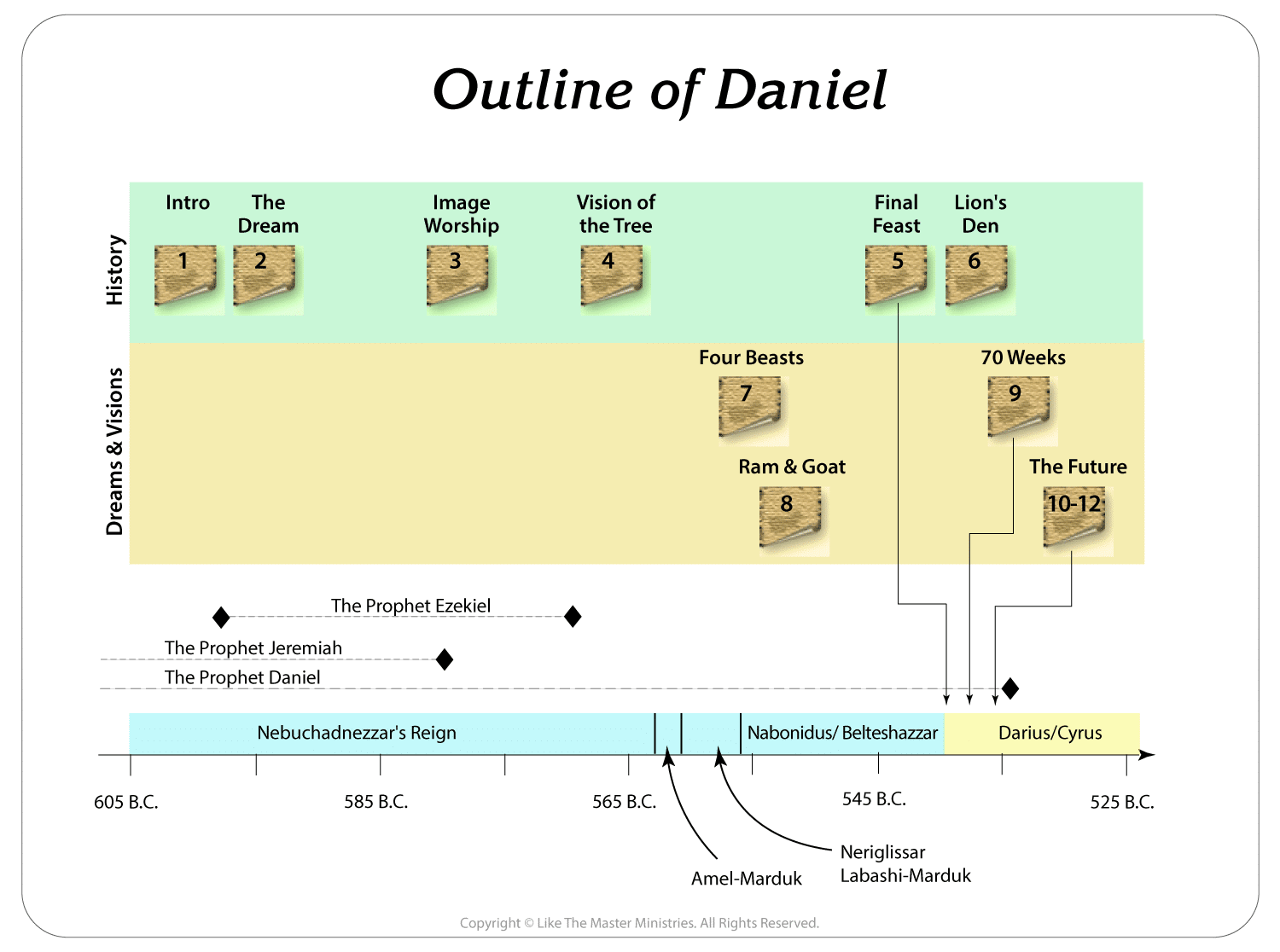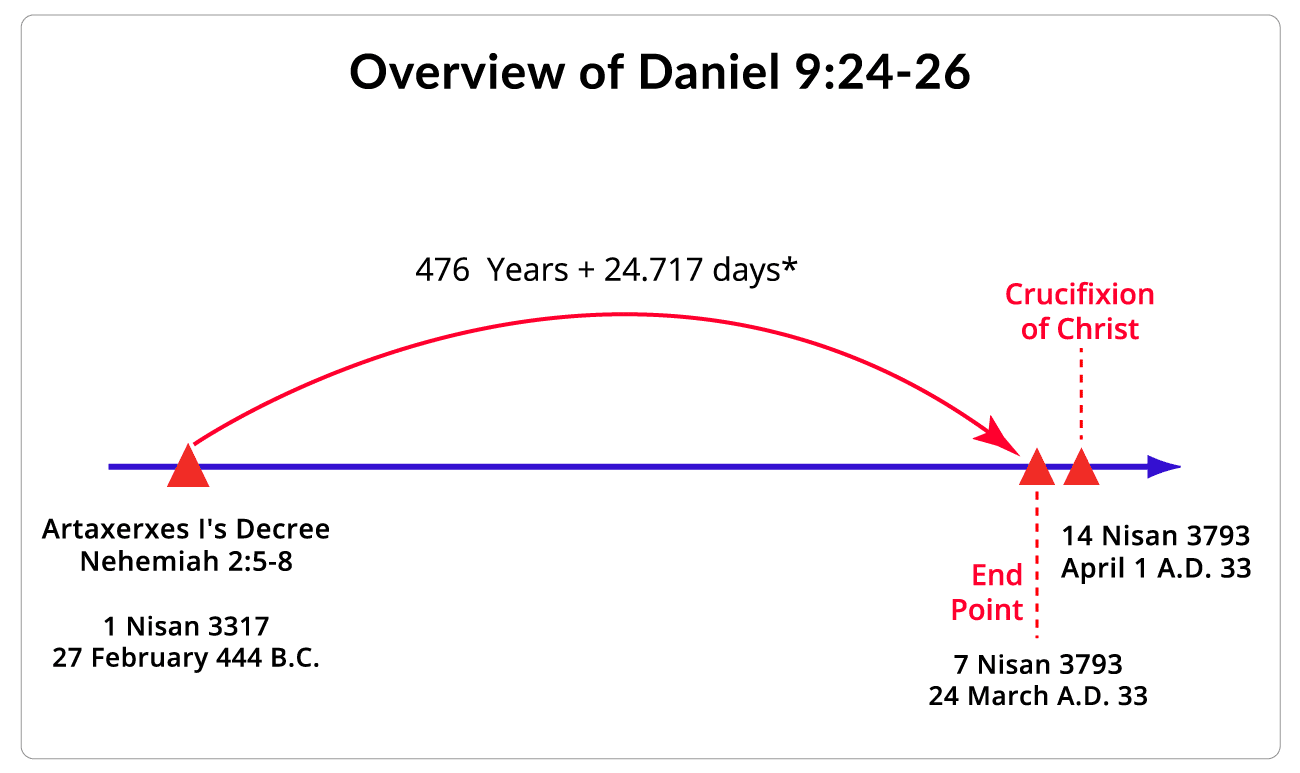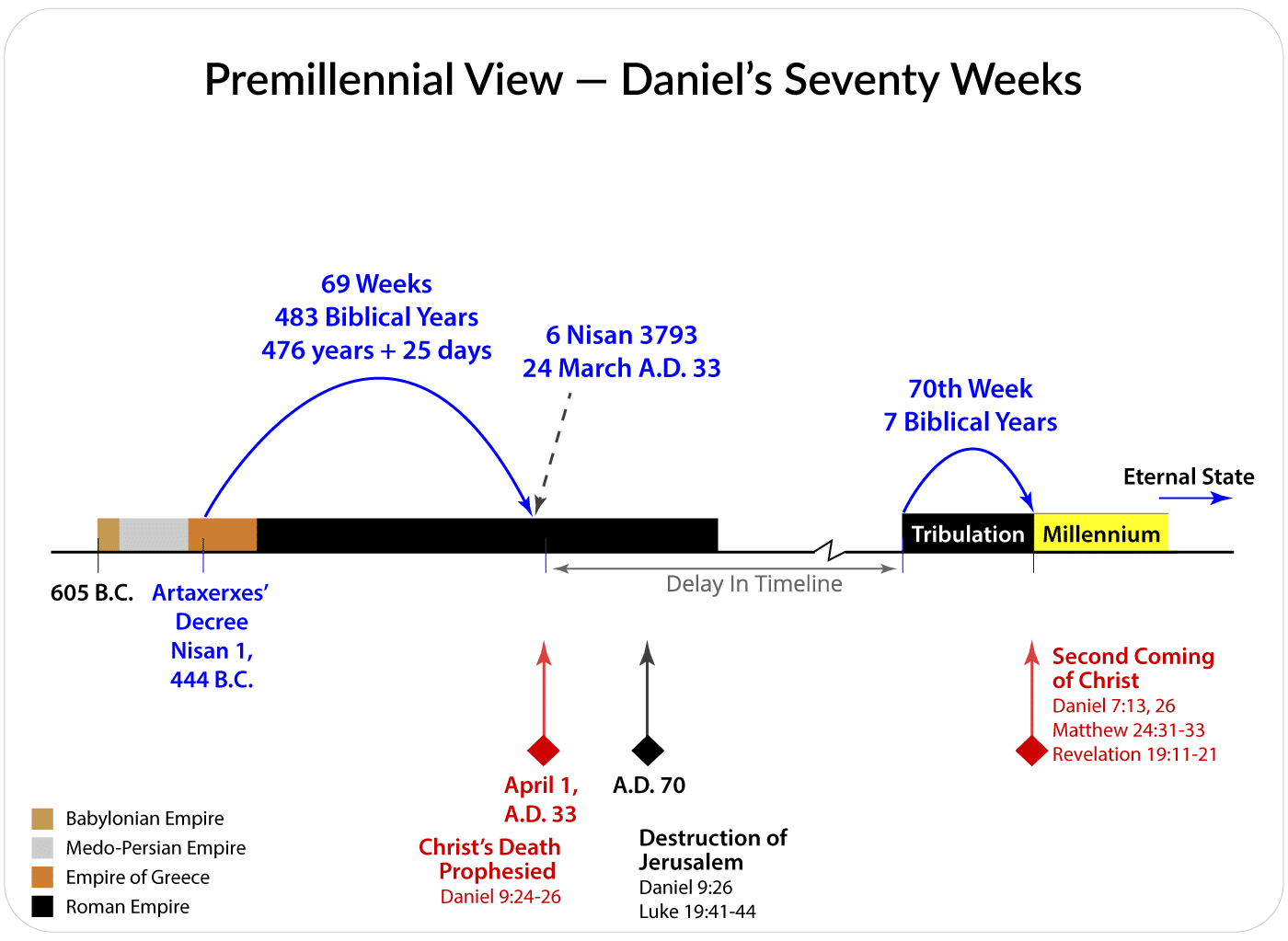
Gap Exists Before the Tribulation
This is a wonderful study from my perspective. I would encourage you to turn to Daniel 9:24. Before we begin I would like to just make a couple of points. The first point is that last time we established an important biblical principle that many people miss. That is, when you come to Scripture, we need to understand and take what we read literally. We need to understand Scripture literally, not figuratively, allegorically, or symbolically. There are some symbols in Scripture that are explained for us; but in general,we need to understand Scripture literally.
Time Gaps In Scripture
Before we get into Daniel 9, I want to establish another biblical principle. That principle is that there are time gaps in Scripture. At times, they appear in the middle of verses. They may occur between verses. There are even time gaps between chapters. You can be reading along, and if you are not paying attention, all of a sudden there can be a huge time gap. That can cause you to totally miss what is happening.
I want to give you three examples. The first one begins in John 7:2. It describes a conversation between Jesus and his brothers. I always find it interesting that there are those who want to claim that Jesus did not have brothers or sisters. Scripture makes it very clear that He had brothers and sisters. Verse 2 tells us that a feast was coming up. It is called the Feast of Booths. Sometimes it is called the Feast of Tabernacles. In the Jewish calendar, that occurs in our months of September or October.
In verse 3 we are told,
Therefore His brothers said to Him, “Leave here and go into Judea, so that Your disciples also may see Your works which You are doing.” John 7:3 (NASB)
So Jesus’ brothers ask Him, “Why do you not go down to Judea, down to Jerusalem where the feast is going to be held?” An interesting discussion follows in verses four through seven. His brothers told Jesus, “Why do you not go down and do all these great works that you are doing? Then everyone will believe who you are.” Next, we are told that they did not believe in Jesus as their Messiah themselves. So, their comments to Him were sarcasm. They were saying, “You should go do some “tricks”, so to speak.
In verses 8-9 we read this:
“Go up to the feast yourselves; I do not go up to this feast because My time has not yet fully come.” Having said these things to them, He stayed in Galilee. John 7:8-9 (NASB)
Verse 10 then adds,
But when His brothers had gone up to the feast, then He Himself also went up, not publicly, but as if, in secret. John 7:10 (NASB)
Now we are told His brothers go ahead and Jesus follows later. It becomes obvious He does not want to go down to the feast with them. But what we do not realize, between verses 9 and 10 is a gap in time of three to four days. Now you may ask, “How do you know that?”
Look at verse 14. Verse 14 says:
But when it was now the midst of the feast Jesus went up into the temple, and began to teach. John 7:14 (NASB)
What does it mean by the middle of the feast? The feast was a seven-day feast. So if Jesus went to the temple in the middle of the feast, that means about three to four days had gone by. That means roughly three to four days had elapsed between verses 9 and 10. So what is my point? My point is that there is a gap in time between verses 9 and 10, and the text does not tell us that occurred.
Let me give you another example. This one might be a little more thrilling for you. Turn to Micah 5. Micah 5:1 says,
Now muster yourselves in troops, daughter of troops . . . Micah 5:1a (NASB)
This is talking about the troops from the Babylonian Empire, the leader is King Nebuchadnezzar.
They have laid siege against us;
With a rod they will smite the judge of Israel on the cheek. Micah 5:1b (NASB)
This refers to Zedekiah. We are told in 2 Kings and 2 Chronicles that he is bound with bronze chains. So verse 1 describes taking King Zedekiah captive. Now when did that happen? It was not in the time of Christ. It happened about 586 B.C.. Now watch verse 2 says:
But as for you, Bethlehem Ephrathah,
Too little to be among the clans of Judah,
From you One will go forth for Me to be ruler in Israel.
His goings forth are from long ago,
From the days of eternity.
Micah 5:2 (NASB)
Verse 2 is talking about the birth of Christ. It says, “But as for you, Bethlehem Ephrathah, too little to be among the clans of Judah, from you one will go forth.” So the time of verse 1 is 586 B.C., and in verse 2 the time is about 1 or 2 B.C. There is this incredible gap of about 600 years in the white space between verses 1 and 2. This is unbelievable If we keep reading into verse 3, there is another gap. It says,
Therefore He will give them up until the time
When she who is in labor has borne a child.
Then the remainder of His brethren
Will return to the sons of Israel.
Micah 5:3 (NASB)
When it says “then the remainder of His brethren will return to the sons of Israel,” there is now a gap of several hundred years. It jumps to the future. And verse 4 says,
And He will arise and shepherd His flock
In the strength of the LORD,
In the majesty of the name of the LORD His God.
And they will remain,
Because at that time He will be great
To the ends of the earth.
Micah 5:4 (NASB)
Then watch verse 5.
This One will be our peace.
Micah 5:5a (NASB)
Who is our peace? Jesus. So the passage is talking about Jesus. The time of verse 1 is 586 B.C., and then suddenly the passage jumps to 1 to 2 B.C. A 600-year jump in time occurs between verse 1 and verse 2. Then verse 3 jumps thousands of years into the future.
Let me give you a third example. Turn to Daniel 8:8. In Daniel 8 we are told,
Then the male goat magnified himself exceedingly. But as soon as he was mighty, the large horn was broken; and in its place there came up four conspicuous horns toward the four winds of heaven. Daniel 8:8 (NASB)
This is explained in verse 22. There we are told that the male goat is Alexander the Great. Alexander the Great had four generals. After Alexander died, they divided up the kingdom into four smaller empires. Now look at verse 9. We are told,
Out of one of them came forth a rather small horn.
Daniel 8:9a (NASB)
The time referred to in verse 8 is 330 B.C., roughly. What is the time of verse 9? The verses is about Antiochus IV Epiphanes. The time was 164-167 B.C. There is a 160-year or 164-year gap between these verses.
I wanted you to see that there are time gaps in the middle of verses, and between verses. I have already made the point there are time gaps between chapters. We will not do that this time. You ask, “Why is that important?” You will see very shortly.
Before we go to verse 26, I want to remind you of our last study. We discovered from verse 24 that the angel Gabriel described a seventy-week period. The seventy week-period was really 490 years. Daniel 9:24 says,
Seventy weeks have been decreed for your people and your holy city. Daniel 9:24 (NASB)
Gabriel is speaking in verses 24 through 27. He makes two simple prophecies. The first prophecy is about the date of the Messiah’s death; and the last prophecy is about the antichrist’s rule. We call it the tribulation period.
Verse 24 summarizes verses 25 through 27. Verses 25 and 26 told us that from the decree to rebuild the city of Jerusalem there would be sixty-two weeks to the death of Christ. Last time we determined the date the decree was given for the rebuilding of the Jerusalem was Nisan 1, 444 B.C. Then we counted sixty-nine weeks or 483 biblical years from that date Then when we converted, the end date was March 24, A.D. 33. Jesus died on Nisan 14, 33 A.D. This is an unbelievable prophecy for it prophesied the date after which the Messiah would die. Anybody who died before that date could not be the Messiah. Anybody who died much after that date would not qualify to be the Messiah either for verse 26 says that after the sixty-nine weeks, the Messiah would be cut off. The Hebrew word for “cut off” says “not.” He would not be. He would be cut off.”
I want to make two important points before we continue. The first is that some people say that because the sixty-nine weeks are divided into seven weeks and sixty-two weeks, the seven weeks are special. They believe the seven weeks are forty-nine years and that is how long it took them to rebuild the temple. Then they guess as to when the temple was built. There are problems with trying to make the forty-nine years, or the seven weeks apply to Jerusalem or the temple. They have trouble because the dates do not line up.
There is a simple solution to this. Genesis 25:7 says,
These are all the years of Abraham’s life that he lived, one hundred and seventy-five years. Genesis 25:7 (NASB)
Did you know that the Hebrew breaks his years up, that is the 175 years? The Hebrew text breaks it up into 100 years followed by 75 years. Just as Daniel says 7 weeks and 62 weeks. I do not think Daniel was trying to communicate anything special.
The other point I want you to notice in the middle of verse 25 is that it says,
. . . rebuild Jerusalem until Messiah the Prince. . .
In 26 it says,
Then after the sixty-two weeks the Messiah . . .
Some of your Bibles say “anointed one.” Did you know that the Hebrew word for Messiah is masiah? The Hebrew word can also mean anointed one. So this is about the death of Messiah. The death of Jesus occurred after sixty-nine weeks, that is, after March 24, A.D. 33, on April 1, A.D. 33.
After the decree to rebuild Jerusalem, there were sixty-nine weeks to the death of Christ on the cross. That is what we discovered last week.
The Tribulation
Our study starts in verse 26, in the middle of the verse. It says,
. . . and the people of the prince who is to come will destroy the city and the sanctuary. And its end will come with a flood; even to the end there will be war; desolations are determined. Daniel 9:26a (NASB)
Now this is very important. Remember – we just finished talking about an important biblical principle that there are time gaps in Scripture. Look at the verse. It says, “Then after the sixty-two weeks the Messiah will be cut off and have nothing.” That is, He was crucified. Then we are told, “And the people of the prince who is to come will destroy the city and the sanctuary.” The first question is when was Jerusalem and the temple destroyed after Christ died? It occurred in 70 A.D. In 70 A.D. the Romans destroyed Jerusalem and the temple. That is what the last part of this verse is about.
Now here is the question. Where is the time gap? The time gap is between the death of Christ and the destruction of Jerusalem. There is a forty-year time gap in the middle of the verse,. We are told Messiah is cut off. Then we are told the people of the prince who is to come will destroy the city and the sanctuary. There is a forty-year time gap in the middle of the verse. There is a time gap of at least 2,000-years between verse 26 and verse 27. In verse 26 we are told that the people of the prince who is to come will destroy Jerusalem and the temple.
I have another important question for you. Who are the people of the prince? I will tell you who they are not. They are not the prince because we are told they are the people of the prince. Who destroyed Jerusalem and the temple? The Roman soldiers are the people who destroyed Jerusalem. They are the people who destroyed the temple. It is not the prince. This is important It is the people who destroy the city, and the temple. Then “its end will come with the flood. Even to the end there will be war. Desolations are determined.”
When you come to verse 27, there is another time gap.
And he will make a firm covenant with the many for one week, but in the middle of the week he will put a stop to sacrifice and grain offering; and on the wing of abominations will come one who makes desolate, even until a complete destruction, one that is decreed, is poured out on the one who makes desolate. Daniel 9:27 (NASB)
The first part of the verse states, “And he will make a firm covenant with the many for one . . .” The he is the prince and is the one described here. That tells us there is a time gap of thousands of years between verses 26 and 27. In verse 26 we were told “the prince who is to come will destroy the city and the sanctuary.” The prince is to come. He was not present in A.D. 70, but he will be in the future. This is another time gap.
Next, we are told that he will be in control for a seven-year period. We call this seven-year period the tribulation period. Now I want to put a couple of pieces together. First, some people have said that the prince is really Jesus. They believe the covenant He will establish is the new covenant. But that covenant was established when Jesus died on the cross. I have a problem with that view. One reason that cannot be true is the covenant in Daniel 9:27 will last for only seven years. When Jesus died on a cross, the new covenant established was a covenant that will last forever. So the prince cannot be Jesus, and the seven-year-covenant cannot be the new covenant. Instead it is a peace treaty. The prince is not Jesus. The prince is the antichrist, as we will discover later.
So the prince makes a peace treaty for seven years. I want you to see some of the details in this verse. We are told,
And he will make a firm covenant with the many for one week, but in the middle of the week he will put a stop to sacrifice and grain offering . . . Daniel 9:27a (NASB)
After making the covenant, peace lasts only for 3 1/2 years. The antichrist stops the grain offering and sacrifice. Those are sacrifices and offerings that are made in the temple in Jerusalem. That means the antichrist interferes with Jewish worship.
Next, we are told,
. . . and on the wing of abominations will come one who makes desolate . . . Daniel 9:27b (NASB)
The abomination will occur in the temple. Do you remember what Antiochus Epiphanes did? Tradition says he put an idol of Zeus, in the temple. The Jews considered that to be an abomination. So when we are told “on the wing of abomination,” that implies the antichrist will do something really bad. 2 Thessalonians 2:3 describes what the antichrist will do.
Let no one in any way deceive you, for it will not come unless the apostasy comes first, and the man of lawlessness is revealed, the son of destruction . . . 2 Thessalonians 2:3 (NASB)
Here we are told that the antichrist, the prince, is also called the man of lawlessness or the son of destruction. Verse 4 tells us what he will do.
. . . who opposes and exalts himself above every so-called god or object of worship, so that he takes his seat in the temple of God, displaying himself as being God. 2 Thessalonians 2:4 (NASB)
In the middle of the seven-year period, after three-and-a-half years, he goes into the temple and sets himself up as God. He sits in the temple for are told, “He takes his seat in the temple of God, displaying himself as being God.” Now that is an abomination! That is blasphemy. That is what we are told in Daniel 9:27—”on the wing of abominations.” Then we are told, “he makes desolate.” He kills many people.

The Antichrist
So who is this prince? We have already learned he is the antichrist, the man of lawlessness. But how do I demonstrate that to everyone from Daniel? Look back at verse 26. Verse 26 says,
. . . and the people of the prince who is to come . . . Daniel 9:26a (NASB)
The actual Hebrew of the phrase “who is to come” means “the one coming.” He was mentioned in Daniel 7:24. In verse 24 we were told that there will be ten kings. That is an alliance of ten nations. Then one of the kings will subdue three others. That means he eliminates three of the ten kings. Seven are left. When we add him, there will be eight kings. Then Daniel 7:25 says.
He will speak out against the Most High and wear down the saints of the Highest One . . . Daniel 7:25a (NASB)
Now watch what it says.
. . . and he will intend to make alterations in times and in law . . . Daniel 7:25b (NASB)
What does he do? He will dare to alter the Mosaic Law.
The last part of verse 25 tells us how long the antichrist will be in control.
. . . and they will be given into his hand for a time, times, and half a time. Daniel 7:25c (NASB)
How long is that? We discovered the answer when we studied Daniel 7. We discovered that “time, times, and half a time” is three-and-a-half years. The antichrist in verse 25 is the same man in Daniel 9:27—the prince.
Tribulation to the Kingdom
Now Daniel 9:26-27 makes a lot of sense. There is an incredible gap of time of at least two thousand years. Verse 27 reveals there will be a tribulation period, a seven-year period, and a man called the prince. In the middle of the tribulation he sits on the throne. The first part of the tribulation will be a time of peace. The last part is called the great tribulation.
In Matthew 24:15 Jesus makes this unbelievable statement. His disciples had asked, “When is your coming, and what are the signs of the age?” He says,
Therefore when you see the ABOMINATION OF DESOLATION which was spoken of through Daniel the prophet, standing in the holy place ( let the reader understand) . . . Matthew 24:15 (NASB)
Jesus confirms here what we just finished studying. He confirms that Daniel 9:27 is about a man who will be in the Holy Place. The prince will be in the Holy Place.
Then Jesus tells us the last part of the tribulation is called the great tribulation in verse 21. That is when all the horrors will actually occur. At the end of the tribulation the battle of Armageddon will occur. Jesus says in verse 29,
But immediately after the tribulation of those days. . . Matthew 25:29a (NASB)
Here Jesus repeats that He has been describing as the tribulation.
. . . THE SUN WILL BE DARKENED, AND THE MOON WILL NOT GIVE ITS LIGHT, AND THE STARS WILL FALL from the sky, and the powers of the heavens will be shaken. And then the sign of the Son of Man will appear in the sky, and then all the tribes of the earth will mourn, and they will see the SON OF MAN COMING ON THE CLOUDS OF THE SKY with power and great glory. Matthew 25:29b-30 (NASB)
This describes the second coming at the end of the tribulation period and followed by the millennial kingdom. The millennial kingdom is described in Revelation 20:4. It will last for a thousand years.

Conclusion
It is unbelievable what Daniel chapter 9 reveals. It gives us a panorama of our future. Verse 27 jumps thousands of years into the future, and we have no idea how much longer it is going to be before Jesus returns. We call it the Second Coming of Christ. But when He comes, He defeats the nations of the world, establishes His kingdom, rules for a thousand years, and then the eternal state begins.
Some claim that what I just taught is wrong. But the early church father Ephraim the Syrian, who lived from A.D. 306 to 337, understood that Scripture teaches a future tribulation period, followed by the second coming of Christ, and the millennial kingdom. Papias, Justin Martyr, and Tertullian taught the same sequence of events.
Now I have to ask you an important question: Are you interested in the millennial kingdom? Are you interested in the thousand-year kingdom? If you are a Christian you should be interested because someday you will be there. Have you ever thought about the opportunity to be in the millennial kingdom? Revelation 19 tells us that we are going to join Jesus at His second coming! We are going to watch Him destroy the armies of the world at the battle of Armageddon. You are going to be in the kingdom with Christ and see Him sit on and reign from His throne in His kingdom. We also will judge some of the angels. Have you ever thought about the opportunity to be in the kingdom?
I want you to see what the kingdom is like. First of all, turn to Isaiah 9 and look at verses 6-7. They say,
For a child will be born to us, a son will be given to us;
And the government will rest on His shoulders;
And His name will be called Wonderful Counselor, Mighty God,
Eternal Father, Prince of Peace.
There will be no end to the increase of His government or of peace,
On the throne of David and over his kingdom,
To establish it and to uphold it with justice and righteousness
From then on and forevermore.
The zeal of the LORD of hosts will accomplish this. Isaiah 9:6-7 (NASB)
So who is sitting on the throne? Jesus! When it says the throne of David, remember that in 2 Samuel 7:14-16, God promised David that one of his descendants would sit on his throne and reign forever. Jesus will be sitting on that throne.
Now look at Isaiah 2:2. Here is a description of the kingdom.
Now it will come about that
In the last days
The mountain of the house of the LORD
Will be established as the chief of the mountains,
And will be raised above the hills;
And all the nations will stream to it.
And many peoples will come and say,
“Come, let us go up to the mountain of the LORD,
To the house of the God of Jacob;
That He may teach us concerning His ways
And that we may walk in His paths.”
For the law will go forth from Zion
And the word of the LORD from Jerusalem.
And He will judge between the nations,
And will render decisions for many peoples;
And they will hammer their swords into plowshares and their spears into pruning hooks.
Nation will not lift up sword against nation,
And never again will they learn war.
Isaiah 2:2-4 (NASB)
That described peace and not war. Look at Isaiah 11:3-5.
And He will delight in the fear of the LORD,
And He will not judge by what His eyes see,
Nor make a decision by what His ears hear;
But with righteousness He will judge the poor,
And decide with fairness for the afflicted of the earth;
And He will strike the earth with the rod of His mouth,
And with the breath of His lips He will slay the wicked.
Also righteousness will be the belt about His loins,
And faithfulness the belt about His waist.
Isaiah 11:3-5 (NASB)
Now watch verse 6-9. You have heard this before.
And the wolf will dwell with the lamb,
And the leopard will lie down with the young goat,
And the calf and the young lion and the fatling together;
And a little boy will lead them.
Also the cow and the bear will graze,
Their young will lie down together,
And the lion will eat straw like the ox.
The nursing child will play by the hole of the cobra,
And the weaned child will put his hand on the viper’s den.
They will not hurt or destroy in all My holy mountain,
For the earth will be full of the knowledge of the LORD
As the waters cover the sea.
Isaiah 11:6-9 (NASB)
What is the message? The message is that the animal kingdom will be changed in an unbelievable way. Can you imagine being able to play with a cobra in safety? That is what is promised in the millennial kingdom. Would you like to see that someday? I am looking forward to seeing that someday—having that experience.
Let us pray. Father, we thank you for your Word. We thank you, Father, for the prophecy that is given in Daniel. We thank you, Father, for the assurance that there is a day when we are going to be together with you in your kingdom, and we are going to be able to experience it. We look forward to seeing the animals play together, and the children play with the snakes. We thank you, Father for the peace we will experience. Thank you in Jesus’ name. Amen.
Suggested Links:
Book of DanielDaniel’s Prayer of Confession and Repentance
Daniel’s Prayer of Confession and Requests
What will happen in heaven during the tribulation period?
ow to Identify the Antichrist
What Will the Antichrist Do?

